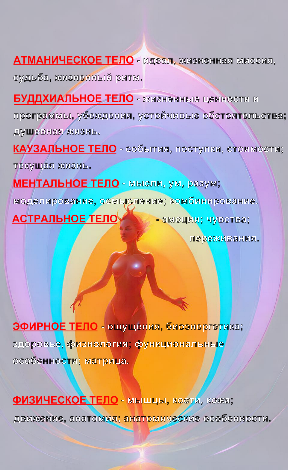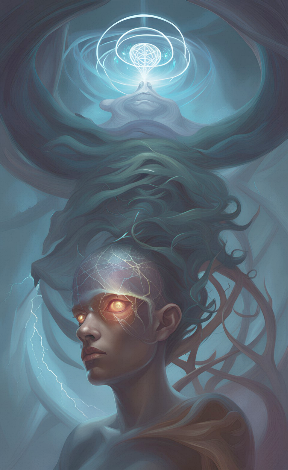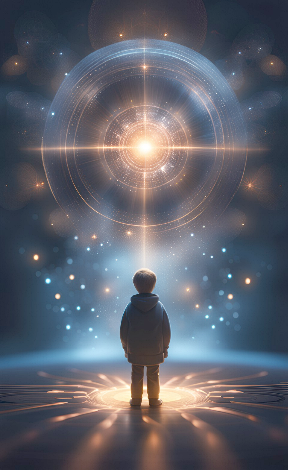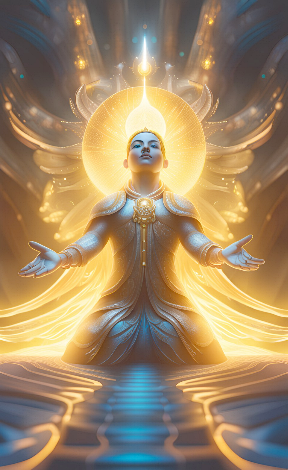Higher Bodies (Soul). The Atmanic Body
This topic continues the introductory theme "Seven Bodies and Seven Channels". It is recommended to begin studying the sections, if possible, from top to bottom.
No matter how complexly events in a person's external and internal world unfold, their goal is unified: to help a person understand (and help others understand) the structure of the world and of themselves, to see the higher self beyond the lower self, the subtle world beyond the observable, and beyond that, the Absolute.
The power of the ideal must be enough
to stop a person.
The Atmanic Body
Keywords: ideal, life mission, fate, life rhythm.
The Atmanic Body is the most subtle of the seven bodies, representing for ordinary consciousness an extremely delicate subject, at least one that is very difficult to grasp rationally. It contains information that defines the mission, that is, the main purpose of a person in their life, as well as the main features of their destiny, within which this mission will be carried out.
The energy of the Atmanic body is the most important of all energies influencing a person's life. Atmanic vibrations, when registered by consciousness, are perceived by a person as an absolute authority, not subject to doubt or correction. As an explanation for their actions dictated by Atmanic energies, they usually say: "I couldn't do otherwise," and further comment ceases. Thus, a future musician will be captivated by a first-heard violin melody, and a pastry chef by the sight of a walnut cake, whose taste they will anticipate from a distance with complete certainty.
The Atmanic body can be strong and weak, loose and dense, amorphous and clearly defined, clean and well-maintained or, conversely, dirty and teeming with parasites, and a person should think about all this from time to time, guessing its most pressing needs from indirect (and sometimes direct) signs and satisfying them as much as possible.
As a rule, it is hidden from a person's consciousness or felt by them extremely vaguely, but sometimes, on the contrary, it manifests itself with extraordinary clarity, and then a person's usual state of consciousness and perception changes, making visible things they could not have suspected. Upon returning, the person usually forgets the experience, but retains a general feeling of something extraordinary and bright that cannot find adequate words and concepts for expression in ordinary language.
A mission is not a person's entire life. More precisely, different circumstances and plots of life have different relations to the mission: some are direct, others are only indirect. Accordingly, Atmanic transmissions in the first case will be frequent and definite, while in the second they will be much less, and the person may even feel a certain "freedom" in connection with this, which in this case is nothing more than an opportunity to surrender part of their life to the disposal of chaotic forces.
The main method for perfecting the Atmanic body is the formation of an ideal corresponding to the person's mission, and the destruction of ideals unrelated to it. The mission is reflected in all subtle bodies, and in accordance with it, a person builds a world view and an ethical system (Buddhic body), a series of concrete events occur (Causal body) that are understood in a certain way (Mental body) and experienced (Astral, Etheric, and Physical bodies).
The main principle of organism management states: the part of the organism that receives a person's attention changes first. How exactly this part will change is another question, but in any case, by purposefully engaging with their Atmanic body, a person invariably changes it.
One cannot live without ideals, as they represent the primary and irreplaceable source of the organism's energy. The complexity lies in the peculiar selectivity of the Atmanic body, for which the energy of ideals that do not correspond to the mission proves unacceptable. Approaching one's ideal manifests more than clearly — a person has no doubt that they want something definite — they want it with their whole being and without the slightest reservation, feeling the connection to the karmic egregore, as an influx of strength and clarity of understanding of the path ahead.
However, the calling in life is not always discovered with such force and early enough. More often than not, the ideal has to be searched for a long time and with a feeling of complete hopelessness, and many people believe that they will get by anyway, and they displace all specific Atmanic problems into the subconscious. Of course, the Atmanic body does not disappear from this, but falls into disuse. Energy flows through it decrease and degrade, and various parasites settle in it: the person begins to feel a special spiritual stagnation, longing, quiet pessimism, and the hopelessness of their circumstances and of themselves. If this illness is neglected, it gradually descends and affects all bodies, including the physical, and then treatment becomes very difficult.
If the ideal is nevertheless discovered, then, as a rule, the person still has a long way to go to formalize it and protect it from the aggressive Atmanic environment of their surroundings.
One can distinguish four main phases of Atmanic body development. In the first phase, a person feeds on the energy of generally accessible ideals, perhaps not particularly pure, but this does not bother them. In the second phase, this energy ceases to satisfy them, and the person begins spiritual searches in the narrow sense of the word, i.e., seeks ideals and higher goals that will inspire them. In the third phase, these ideals are found, and the person joyfully begins to serve them. In all these phases, however, they act as a consumer of the Atmanic energy of the external world, or rather, the Atmanic plane. Only in the next, fourth phase, do they begin to work, forming new ideals in some Atmanic egregore, which other people can later use.
A person with a strong Atmanic body can become a religious leader — people follow them, destroying their former lives and not regretting it, because the leader gives them a sense of fullness and the highest meaning of being, and in their presence, they are simply happy — without any visible reasons. This kind of Atmanic connection is characterized by selflessness, absolute devotion, and the complete impossibility of their rational-mental explanation.
Ideals are of four types: light, intermediate, dark, and puppet, or sham. Light ideals are symbols of channels to high Atmanic egregors; dark ones — to low ones (also Atmanic); puppet ideals are not ideals in the strict sense of the word, i.e., there are actually no channels to any Atmanic egregore behind them, but they claim to be and can be used by a person for applied purposes.
In a strong Atmanic body, confusing a real ideal with a puppet one is quite difficult: they differ roughly as a live puppy from a wind-up toy. However, with weak Atmanic energy, the difference at first glance is not so obvious, as all movements are as if greatly slowed down, but still, a real ideal is something alive, and a puppet one is not. Behind the first, there is nothing; behind the second, there is an egregore — practically an unlimited source of energy. Nevertheless, a puppet ideal also possesses a certain energy — that which was expended on its creation as a certain object in the Atmanic body.
The mental age has accustomed us to the idea that truth is what can be proven. However, such a judgment does not stand up to criticism, if only because the very concept of "proof" belongs to the mental plane and is inapplicable to the others, not to mention that arguments considered very convincing in one era sound in another, at best, like a parody of proof, and at worst — like outright nonsense.
Puppet ideals are very easy to identify: they do not cause any reciprocal vibrations of the Atmanic body, meaning a person does not feel a higher uplift, enthusiasm, a feeling of extraordinary joy, a desire to dedicate their whole life to the ideal, or anything of that kind.
Thus, spiritual teachers can be divided into three main categories: white, black, and gray. The first connect their students to high Atmanic egregors, forming and activating high ideals; the second, on the contrary, orient students downwards, towards rigid Atmanic egregors and Satanic ideals; the third disconnect students from any Atmanic egregors whatsoever, closing their channels to a puppet ideal, and through it absorbing the Atmanic energy they possess.
Ideals can be compared to lighthouses, which are simultaneously refueling stations, on the winding river of individual evolution. To see an ideal, one must exert some effort. But approaching it is rewarded with a significant energy quantum — until the next lighthouse appears, automatically canceling the old one and requiring the person to change course. Of course, ideals rarely change to directly opposite ones, but they are sometimes corrected very significantly during life. However, in addition to one's own lighthouses, one can often see others, or pirate signal lights, luring the ship onto the rocks, as well as buoys that do not shine by themselves, but merely reflect the light cast upon them and indicate no path — such are puppet ideals.
The task of a spiritual teacher is to help a person navigate among the surrounding signal lights. A **white teacher** will point to the next lighthouse — but the student must see it (and change course) themselves; a black teacher will point to one or another pirate lighthouse — and at the head of the pirates, will feast on the Atmanic energy released during the shipwreck, and with great luck, capture prisoners and sell their souls into slavery to Gagttungr. A gray teacher will try to direct the student's course towards meaningless buoys, that is, to orient them towards sham ideals, so as to vampirically connect to the student's Atmanic body through them and imperceptibly absorb their energy.
It should be noted that a person's true teacher will be one who helps them approach a more precise fulfillment of their individual mission. This help may be needed on any body — it is only important that it arrives on time and is adequate. However, traditionally, a spiritual teacher is a person working with Atmanic and partially Buddhic energy, and the author will follow this definition.
Black teachers are typical for people (and times) with strong Atmanic energy, when many ideals arise, in which a person begins to get confused: genuine, meaning those that open the way to one Atmanic egregore or another, they all are, but the mission requires a precise choice, which the person is not yet capable of. Then a black spiritual teacher appears, firmly orienting the person towards ideals that clearly do not correspond to their mission. After some time, this becomes obvious, and, having gathered a small boat from the wreckage after the "pirate lighthouse," the person embarks on a new spiritual journey with significantly more modest Atmanic energy, but also being much more attentive to the choice of ideal and feedback with it.
Gray teachers are characteristic of people (and times) with reduced Atmanic energy. Here, the energy of ideals is small, meaning their light is dim and recognized with great difficulty — and yet, one must orient oneself towards it, subordinating far stronger underlying bodies (Buddhic, Causal, and so on) to the weak Atmanic body. The reduction of Atmanic energy is perhaps the most difficult trial for a person, a kind of spiritual fast that can last an entire life and is not necessarily connected with past sins: the Cosmos, in particular, the Atmanic plane, has its own rhythms, which are still poorly understood, but exist quite objectively, influencing the destinies of both individuals and entire generations.
Therefore, ideals are always different: the ideal of serving truth, the ideal of honesty, family, group, political, and so on. But the phenomenon of the ideal of shoddy work deserves special philosophical consideration, as this phenomenon has become so widespread that doubt even creeps into the author's soul: has the planetary demon recently changed tactics, replacing the word "evil" on its most outspoken banners with "shoddy work"?
The ideal of shoddy work, in a certain sense, is opposed to the idea of fulfilling one's mission and is closely related to the concepts of equality and replication. A person with a strong Atmanic body and a clearly felt unique individual mission would never conceive of the idea of equality or the urge to cut corners. Personal impressions are usually projected onto the world. And if I feel the uniqueness of my destiny, then, quite naturally, I will transfer this circumstance to other people as well. And not only to people, but also, say, to objects or social groups. Then the idea of equality simply won't fit in my head: the fate of a peasant is one thing, the fate of a city dweller is another, and the fate of a king is a third.
As for shoddy work, it is excluded by strong Atmanic vibrations, which completely encompass a person and directly control** all their bodies. But people fought for freedom of choice without earning it through their evolutionary development. As a result, the connections between the bodies weakened and became unregulated, "freeing" them from each other. Therefore, at the root of shoddy work (and illnesses of the organism) lies a discrepancy between the bodies: I should do one thing (Buddhic body), I do another (Causal), I think about a third (Mental), and I am engrossed in a fourth (Astral).
It should be noted here that, in general, a person's ability to distinguish their bodies and the planes of the subtle world is excellently developed, and one does not need to be a psychic to distinguish the Atmanic body from the Astral. However, the overdeveloped mental body of the average person today tends to interfere in all their affairs, particularly in the meditations of the more subtle bodies, and grossly distorts them. Therefore, attempts at mental modeling of one's subtle experiences inevitably lead to the deformation of the three higher bodies, and, in particular, of religious experience and interaction with the ideal. Faith is not a product of logical reasoning (mental body) or direct external life experience (causal body).
From an egregorial point of view, an ideal is nothing more than a symbol of a channel to an Atmanic egregore. And attunement to this symbol (e.g., repeating a prayer or the name of the Almighty) connects a person to this channel. In this regard, the texts of prayers used by believers acquire great importance, often without considering that, generally speaking, the One Creator knows better than a person what the latter needs.
Perhaps it is my time to fast a little, and He sees this, but I, with my meager intellect, do not notice and ask for things that are better not to have. As for temptations, it is obvious that they are also necessary for me at some point, and He knows best when and in what form the cunning one should be allowed to approach me.
On the other hand, in the case of a sharp imbalance of the body's subtle bodies and energy flows, a precisely found prayer or simply a sincere appeal to one's higher "I" can yield an effect of instant healing or strong relief — but such an appeal is often not easy to find.
The Atmanic Absolute is the source of all possible missions and higher aspirations. Here, the founders of religions draw inspiration. People who creatively realize their life missions sense the breath of the Atmanic Absolute. In some exalted moments, they are given the opportunity to partially correct them, thereby also influencing the cosmic mission of Earth and the Sun. Atmanic creativity is taboo in most religions, as prophets usually claim to bring religious truth in the last instance.








